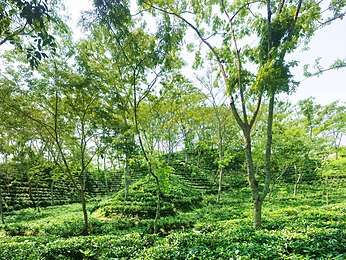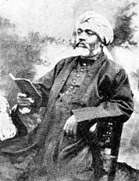Tea production in Bangladesh
Bangladesh is an important tea-producing country. It is the 10th largest tea producer in the world. Its tea industry dates back to British rule, when the East India Company initiated the tea trade in the hills of the Sylhet region.[1] In addition to that, tea cultivation was introduced to Greater Chittagong in 1840. Today, the country has 166 commercial tea estates, including many of the world's largest working plantations.[2][3] The industry accounts for 3% of global tea production, and employs more than 4 million people.[4]

The tea is grown in the northern and eastern districts, the highlands, temperate climate, humidity and heavy rainfall within these districts provide a favourable ground for the production of high-quality tea.[4]
History
Historically, Bengal was the terminus of the Tea Horse Road connecting the subcontinent with China's early tea-growing regions in Yunnan. Atisa is regarded as one of the earliest Bengali drinkers of tea.[5]
Black tea cultivation was introduced in Bengal and Assam during the British Empire, particularly in Assam's Sylhet district.[6] In 1834, Robert Bruce discovered tea plants in the Khasi and Jaintia Hills and other hilly areas in the northeast. This led to the Assam Tea Company being established in 1839 and many businessmen were actively involved with this company such as Haji Mohammed Hashim, Dwarkanath Tagore and Mutty Lall Seal. The company was associated with Calcutta's Bengal Tea Association. European traders established the first subcontinental tea gardens in the port city of Chittagong in 1840, when plantations were set up beside the Chittagong Club using Chinese tea plants from the Calcutta Botanical Garden.[5] The first home-grown tea was made and tasted near the Karnaphuli River in Chittagong in 1843.[5] Commercial cultivation of tea began in the Mulnicherra Estate in Sylhet in 1857. The Surma River Valley in the Sylhet region emerged as the centre of tea cultivation in Eastern Bengal. Plantations also flourished in Lower Tippera (modern Comilla) and Panchagarh which in North Bengal. Panchagarh is the only third tea zone in Bangladesh and most demanded teas cultivated here.
Tea was a major export of British Bengal. The Assam Bengal Railway served as a lifeline for the industry, transporting tea from growers in the Surma and Brahmaputra Valleys to exporters in the Port of Chittagong.[7][8]

In the early twentieth century, many local entrepreneurs also started founding their own companies such as Syed Abdul Majid, Nawab Ali Amjad Khan, Muhammad Bakht Majumdar, Ghulam Rabbani, Syed Ali Akbar Khandakar, Abdur Rasheed Choudhury and Karim Bakhsh.
The Chittagong Tea Auction was established in 1949 by British and Australian traders. British companies such as James Finlay and Duncan Brothers once dominated the industry.[1] The Ispahani family also became a highly prominent player in the industry.[9]
Industry
Tea is the second largest export oriented cash crop of Bangladesh, following jute. The industry accounts for 1% of national GDP.[10] Tea-producing districts include Maulvi Bazar, Habiganj, Sylhet, Chittagong, Panchagarh, Brahmanbaria, Rangamati[11]
Once a major world exporter, Bangladesh is now a net importer of tea.[12] The rise of the Bangladeshi middle class has increasingly driven the industry to focus on a lucrative domestic market. The sector is today dominated by Bangladeshi conglomerates, including M. M. Ispahani Limited, Kazi & Kazi, the Transcom Group, James Finlay Bangladesh, the Orion Group, the Abul Khair Group and Duncan Brothers Bangladesh Limited.
In 2012, Bangladesh recorded its highest production of tea, at 63.85 million kilograms.[13] The country has over 56,846 hectares of land under tea cultivation, up from 28,734 hectares in 1947.[2] The government has begun to promote small-scale tea growers, particularly in the Chittagong Hill Tracts.
The price of Bangladesh tea is determined at the public auction in Chittagong. In March 2015, the international price of Bangladesh tea was US$2.40.[14]
Currently, the Moulvibazar District has the most tea plantations in the whole of the country.
Labour
More than 300,000 plantation workers are employed in Bangladeshi tea gardens. 75% of workers are women.[3] Many are descendants of tribal labourers brought from central India by the British.[15]
Government bodies
The Bangladesh Tea Board and the Bangladesh Tea Research Institute support the production, certification and exportation of the tea trade in the country.[16] The Bangladesh Tea Research Institute began the improvement of tea quality in 1957, selecting bushes with the best yield and quality to introduce germplasm as a system of improvement.[17]
References
- "Tea Industry". Banglapedia: National Encyclopedia of Bangladesh. Asiatic Society of Bangladesh.
- Dr. Kazi Muzafar Ahammed. "Investment for Sustainable Development of Bangladesh Tea Industry – An Empirical Study" (PDF). Bangladesh Economic Association. Retrieved 3 April 2015.
- "Tea Gardens in Bangladesh". bangladesh.com. Retrieved 24 March 2015.
- "Tea". scribd.com. Retrieved 24 March 2015.
- "Saving the Slips Between Cup and Lips". Firstnewsmagazine.com. Retrieved 3 April 2015.
- Colleen Taylor Sen (2004). Food Culture in India. Greenwood Publishing Group. p. 26. ISBN 978-0-313-32487-1.
- Ishrat Alam; Syed Ejaz Hussain (2011). The Varied Facets of History: Essays in Honour of Aniruddha Ray. Primus Books. p. 273. ISBN 978-93-80607-16-0.
- Alan Warren (1 December 2011). Burma 1942: The Road from Rangoon to Mandalay. A&C Black. p. 235. ISBN 978-1-4411-0673-5.
- Ispahani Family, Banglapedia
- "Tea @ Global Trade Concern – Bangladesh". Tea.globaltradeconcern.com. Retrieved 3 April 2015.
- "Bangladesh Tea Board". Teaboard.gov.bd. Retrieved 3 April 2015.
- "Growth of imports shake tea gardens of northern Bangladesh". The Daily Star. 5 December 2014. Retrieved 3 April 2015.
- "Bangladesh records highest tea production in 2012". thedailystar.net. Retrieved 24 March 2015.
- "Bangladesh tea prices edge up on strong demand". dhakatribune.com. Retrieved 24 March 2015.
- "As tea estates expand in Bangladesh, tribes fear for their future". ucanews.com. Retrieved 24 March 2015.
- Bangladesh Tea Research Institute, Banglapedia
- Chen, Liang; Apostolides, Zeno; Chen, Zong-Mao (2012). Global Tea Breeding: Achievements, Challenges and Perspectives. Hangzhou: Zhejiang University Press. p. 290.